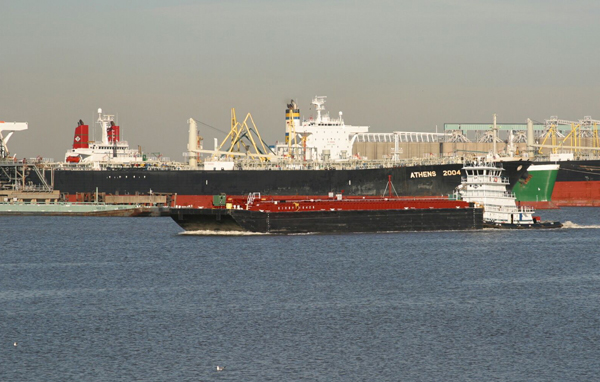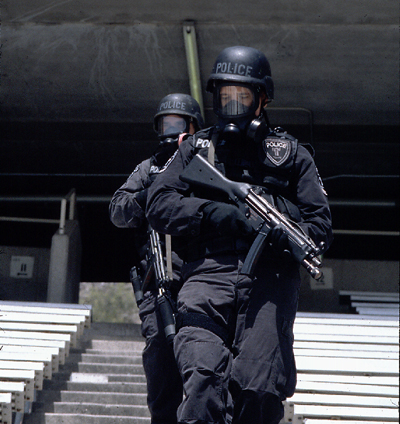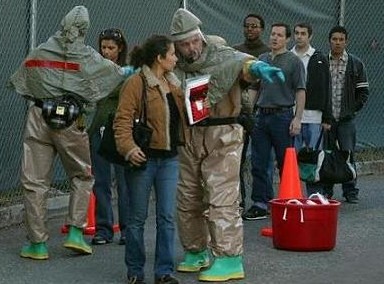Description
Certain Dangerous Cargoes (CDCs) are defined by 33 CFR 1610.204 as having chemical properties that, if released unexpectedly, would have the capability to cause grave consequences to populations and critical infrastructure.
Dangerous Cargoes Package includes five programs that cover the five commodities that are considered the most hazardous when carried in bulk, and are the ones focused on by the US Coast Guard. Package also includes two resource CD-ROMs.
Total runtime: 140 minutes. Produced by Emergency Film Group.
Titles included:
Anhydrous Ammonia DVD
This training video teaches about Anhydrous Ammonia safety and response to Anhydrous Ammonia incidents
Anhydrous Ammonia DVD is a safety training video about the hazards of Anhydrous Ammonia and safe response to incidents involving this dangerous gas.
- Hazard properties
- New DHS reporting and security requirements
- Up-to-date standards for containers
- For risk management planning: new information on toxic endpoints for anhydrous ammonia
- Illegal use of anhydrous ammonia in meth labs
- DOT and NFPA placards and labels
- Air monitoring and ventilation
- Special problems posed by enclosed spaces
- Newest information about controlling vapors after spills
- Use of water fog spray, carbon dioxide and foam to control vapors
- Protective equipment used in emergency response
Includes a Resource CD-ROM with customizable PowerPoint presentation, post-seminar quiz and other instructional aids.
Inorganic Oxidizers DVD
Inorganic Oxidizers safety training video covers Nitric Acid, Ammonium Nitrate and Calcium Hypochlorite
Inorganic Oxidizers DVD is a safety training video for workers and for emergency response personnel who require safety training because they work with or may respond to an incident involving inorganic oxidizers.
This program examines the most common inorganic oxidizers: ammonium nitrate, calcium hypochlorite and nitric acid.
Topics covered include:
- Basic hazard properties of liquid and solid oxidizers
- Safety techniques for handling an emergency involving inorganic oxidizers
- Where oxidizers might be found
- What hazards are specific to each chemical
- Symptoms of exposure
- How to assist victims who have been contaminated by oxidizers
- Safe storage and handling procedures
- Incompatibility issues
- First response, size-up, protective clothing and breathing apparatus for incidents
- Isolating the scene
- Controlling vapors, containing the spill, and evacuation
- Containers, DOT placarding, NFPA markings
- Protecting water supplies
- Fire fighting, decontamination and cleaning up spills
Chlorine DVD
This safety training video teaches the hazards of Chlorine and safe response to Chlorine incidents
Chlorine DVD is a safety training video about the hazards of chlorine and safe response to incidents involving chlorine.
Topics covered include:
- Vapor behavior
- Toxic effects of chlorine
- Use of Level A and Level B ensembles during response activities
- Methods of leak detection
- Container design
- Chlorine Institute A, B and C kits
- Use of water to cool containers and for vapor control
Included in the package is an Instructor’s CD-ROM with PowerPoint, post-seminar quiz and other resources helpful in presenting a training session.
Propane, Butane & Propylene DVD
This safety training video teaches the hazard properties of LPG and portrays safe response.
Propane, butane and propylene are the most common liquefied petroleum gases. Highly flammable, their containers can fail with explosive force.
This live action safety training video is for those who work with LPG and for emergency personnel who may respond to an incident where LPG is involved. It covers:
- How to determine fire protection needs for LPG facilities
- Avoiding BLEVEs
- Strategy for handling fires
- Determining water flow to cool tanks exposed to fire
Intermodal Containers DVD
Train your personnel on safety issues of intermodal containers.
Intermodal Containers DVD training video describes containers which can be used interchangeably in different modes of transportation. Examples of intermodal containers include both tank and box containers. More than four million such containers are in use around the world.
Problems may arise when hazardous materials are packed – whether properly or improperly – inside intermodal containers and external markings are not present to warn workers or emergency responders of the contents.
This DVD provides information for emergency responders and industry personnel who work with or who may respond to emergencies involving intermodal containers.
Topics covered include:
- How intermodal containers are constructed and used
- How accidents happen
- Standards for IMO Type 1, Type 2, Type 5 and Type 7 containers
- Features of specialized containers
- Safety procedures to minimize accidents during loading and unloading operations
- Procedures for safe response to emergencies involving both tank and box containers
- Identifying hazardous materials
- Using protective clothing
- Isolating the accident scene
- Managing leaks and fires




